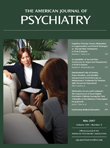Drs. Zalsman and Mann Reply
To The Editor: We thank Drs. Joober, Sengupta, and Schmitz for their comments on our recent study, but we disagree with their conclusions and calculations. They raise the question whether a selection bias operated in selecting a sub-cohort of 79 subjects for the gene-by-environment interaction analysis. The sub-cohort of cases that was used for the gene-by-environment analysis consisted of those subjects who completed the St. Paul-Ramsey Rating Scale for Life Events. Selection effects are always a concern in association studies, but three other published studies report results consistent with our finding that depression is sensitive to life events in the group with the low expressing alleles of this polymorphism (2 –4), despite studying populations of different ages (children, adolescents, and young adults) from different countries (New Zealand, United States, and United Kingdom) and using different measures to assess life events or stress.
The second concern raised by the authors is linked to the source of the observed interaction. They attribute reported gene-by-environment to their speculation about our data that patients with the S′S′ genotype and low stressful life events might have had lower HAM-D scores compared with patients with the L′L′ genotype, while at high stressful life events, both groups might have “equivalent depression scores.” To clarify this, we present the HAM-D scores (SD) and number of patients in the six gene-by-environment strata ( Table 1 ). As can be seen from the table, under high stressful life events, the L′L′ group actually has lower depression scores, both compared with the S′S′ and S′L′ groups and with the L′L′ group under low stressful life events. In contrast, the S′S′ group under high stressful life events almost doubles the depression scores of the S′S′ group under low stressful life events, whereas the L′L′ group has comparable depression scores regardless of stressful life events.
Although our cohort sizes were modest, the results of our study are consistent with the other cited studies (2 –4). Independent replications validate our conclusions more convincingly than a single study with a larger cohort size.
1. Caspi A, Sugden K, Moffitt TE, Taylor A, Craig IW, Harrington H, McClay J, Mill J, Martin J, Braithwaite A, Poulton R: Influence of life stress on depression: moderation by a polymorphism in the 5-HTT gene. Science 2003; 301:386–389Google Scholar
2. Kaufman J, Yang BZ, Douglas-Palumberi H, Houshyar S, Lipschitz D, Krystal JH, Gelernter J: Social supports and serotonin transporter gene moderate depression in maltreated children. Proc Natl Acad Sci U S A 2004; 101:17316–17321Google Scholar
3. Eley TC, Sugden K, Corsico A, Gregory AM, Sham P, McGuffin P, Plomin R, Craig IW: Gene-environment interaction analysis of serotonin system markers with adolescent depression. Mol Psychiatry 2004; 9:908–915Google Scholar




